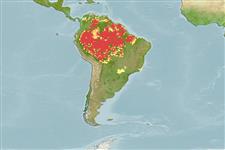Classification / Names
Common names from other countries
Main reference
Size / Weight / Age
Max length : 54.2 cm TL male/unsexed; (Ref. 79585); max. published weight: 1.3 kg (Ref. 40637)
Length at first maturity
Lm 23.2 range ? - ? cm
Environment
Freshwater; demersal; pH range: 6.5 - 7.8; dH range: ? - 20
Climate / Range
Tropical; 23°C - 30°C (Ref. 1672), preferred ?; 8°N - 11°S
Distribution
South America: Amazon, Orinoco, Paraná and Parnaíba River basins. Syntopic with S. elongatus in the Orinoco basin and with S. elongatus and S. maniradii in the upper Amazon drainage of Brazil, Ecuador, Peru, and Bolivia (Ref. 57983).
Countries | FAO areas | Ecosystems | Occurrences | Introductions
Short description
Dorsal
spines
(total): 2;
Dorsal
soft rays
(total): 6;
Anal
soft rays: 19 - 22. Distinguished from S. elongatus by having modally 9 pectoral rays; 21 anal-fin rays; 16 gill rakers; large vomerine tooth patches, almost always fused; a more robust, deeper head and body; body somewhat compressed laterally; mental barbels equal or anterior to gular apex. Differs from S. cuspicaudus in having rounded caudal fin lobes and more robust body; from S. trigonocephalus by premaxillary tooth patch length being 1.5 to 2.5 times its width; trenchantly differs from S. maniradii in having only 13-18 gill rakers. Additionally, other distinguishing characters include, pelvic fins that contact or nearly reach anal fin origin when depressed and presence of thin plates or ossicles (highly variable in shape) extending vertically on anterior lateral line in most large adults (Ref. 57983).
IUCN Red List Status (Ref. 115185)
Threat to humans
Harmless
Human uses
Fisheries: minor commercial; aquarium: commercial
More information
ReferencesAquacultureAquaculture profileStrainsGeneticsAllele frequenciesHeritabilityDiseasesProcessingMass conversion
Tools
Special reports
Download XML
Internet sources
Estimates of some properties based on models
Phylogenetic diversity index
PD50 = 0.5312 many relatives (e.g. carps) 0.5 - 2.0 few relatives (e.g. lungfishes)
Trophic Level
4.1 ±0.71 se; Based on food items.
Resilience
Medium, minimum population doubling time 1.4 - 4.4 years (K=0.27)
Vulnerability
Moderate vulnerability (39 of 100)
Price category
